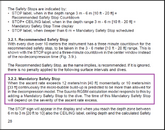I think the error/"algorithm lock" is a natural result of the chosen algorithm.
RGBM is a bubble model -- the algorithm strives to calculate an ascent that doesn't result in unacceptable bubble formation. Once it thinks bubbles have formed (because you missed a stop) there is no solution to the algorithm -- it cannot compute an ascent that doesn't result in bubble formation because that's already happened.
When using Buhlman one can say "well, you're at 180% of the M-value, sucks to be you, but assuming you survived here's how long you need to stay here to get back to your GF". I don't think that option exists in RGBM. I don't think it's a tested scenario for Buhlman either but it's possible to compute something which makes mathematical sense, if perhaps not physiological.




